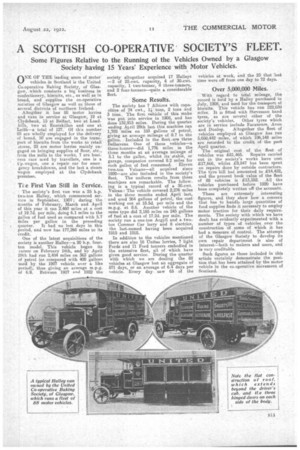A SCOTTISH CO-OPERATIVE SOCIETY'S FLEET.
Page 11

If you've noticed an error in this article please click here to report it so we can fix it.
Some Figures Relative to the Running of the Vehicles Owned by a Glasgow Society having 15 Years Experience with Motor Vehicles.
oNE OF THE leading users of motor vehicles in Scotland is the United Co-operative Baking Society, of Glasgow, which conducts a big business in confectionery, biscuits, etc., as well as in bread, and supplies the co-operative societies of Glasgow as well as those of several districts of northern Ireland.
...kitogther it has 88 motor lorries and vans in service at Glasgow, 19 at Clydebank, 15 at Belfast, two at Lead. hills, two at Enniskillen and one at Leith—a total of 127. Of this number 85 are wholly employed for the delivery of bread, 10 are engaged in the transport of biscuits from the works to retail stores, 23 are motor lorries mainly engaged on bringing supplies of flour, etc., from the mills to the works, 7 are business ears used by ttavellers, one is a t/p-wagon, one a repair car for emergency breakdowns, and the last a steam wagon employed at the Clydebank_ premises.
TLe First Van Still in Service.
• The society's first van was a 25 h.p. two-ton Halley, which commenced service in September, 1907; during the months of February, March and April of this year it ran 2,460 miles at a cost. of 19.7d, per mile, doing 6.1 miles to the gallon of fuel used as compared with 5.7 miles per gallon in the preceding quarter. It had no lost, days in this period, and now has 177,260 miles to its credit.
One of the latest acquisitions of the society is another Hallev—a 20 h.p. fourton model. This vehicle began its career on February 14th, and by April 29th had run 2,434 miles on 363 gallons of petrol (as compared with 400 gallons used by the 1907 vehicle. over a like period), thus giving an average m.p.g. of 6.9. Between 1907 and 1922 the society altogether acquired 17 Halleys —2 of 25-cwt. capacity, 4 of 30-cwt. capacity, 1 two-tanner, 8 three-tonners, and 2 four-tonners—quite a considerable fleet.
Some Results.
The society has 7 Albions with capacities of 24 cwt., 14-• tons, 2 tons and 3 tons.. The first vehicle of this make was put, into service in 1908, and has done 132,915 miles. During the quarter ending April 29th last. this machine rail 1,782 miles on 183 gallons of petrol; giving an average mileage of 9.7 to the gallon. Included in the fleet ,are three 13elliavens. One of these vehicles—a three-tenner—did 1,776 miles in the three months at an average mileage of 5.1 to the gallon, whilst its stable, or garage, companion covered 8.2 miles for each gallon of fuel consumed. Eleven two-ton Vulcans—all acquired since 1920—are also included in the society's fleet. The uniform results from these machines are remarkable. The following is a typical record of a 30-cwt. Vulcan: The vehicle covered 2,276 miles in the three months ended April last, and used 264 gallons of petrol, the cost. working out at 18.5d. per mile and the m.p.g. at 8.6. Another vehicle of the same type did 2,185 miles on 245 gallons of fuel at a cost of 17.2d. per mile. The society run a one-ton Argyll and a twoton Commer Car lorry and 8 electrics, the last-named having been acquired 1915 and 1918.
In addition to the vehicles mentioned there are also 16 Unitas lorries, 7 light Fords and 11 Ford thrillers embodied in the extensive fleet, all of which have given good service. During the quarter with which we are dealing the 88 vehicles at Glasgow lost an aggregate of 571 days, or an average of 6.4 days per vehicle. Every day. saw 65 of the vehicles at work, and the 23 that lost time were off from one day to 72 days.
Over 5,000,000 Miles.
With regard to total mileage, the record is held by a Halley purchased in July, 1908, and used for the transport of biscuits: This vehicle has run 222,039 miles. It is fitted with Stevenson band tyres, as are several other of the society's vehicles. Other tyres which are in service include Faransure, Avon and Dunlop. Altogether the fleet of vehicles employed at, Glasgow has run 5,038,442 miles, of which 196,148 miles are recorded to the credit of the past April quarter. The original cost of the fleet of vehicles was £51,465. Repairs carried out in. the society's works have cost £17,606, whilst £8,847 has been spent on repairs done by outside contractors. The tyre bill hag amounted to £14,422, and the present hook value of the fleet of 88 vehicles is £13,552. All the vehicles purchased before 1920 have been completely written off the accounts.
These are extremely interesting figures, and they show how a concern that has to handle large quantities of food supplies finds it necessary to employ motor traction for their daily require. ments. The society with which we have dealt has evidently experimented with a number of types of vehicles over the construction of some of which it has had a measure of control_ The attempt of the Glasgow Society to develop its own repair department is also of interest—both to makers and users, and is very creditable.
Such figures as those included in this article certainly demonstrate the position that has been attained by the motor vehicle in the co-operative movement of Scotland.


































